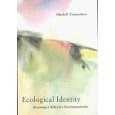
If you take the time to follow the latest climate change research or speak with the world-class scientists who are observing the data, you come away profoundly shaken. In essence they are deeply concerned that climate destabilization is happening much more quickly than even their worst scenarios projected. The most riveting changes prevail at the Poles where the ice is melting at extraordinary rates. If you’re interested in following the fascinating science of climate change, check out Dr. Steven Schneider’s (Stanford University) outstanding website.
About a month ago, I attended the annual conference of the National Council for Science and the Environment. This year’s topic “Climate Change: Science and Solutions” had well over one thousand participants. Speakers and panelists included a broad spectrum of stakeholders, including James Rogers, the CEO of Duke Energy; Abigail Kimbell, Chief of the US Forest Service; and John Holdren, the President of the Woods Hole Research Center. Amongst the dozens of luminaries were hundreds of concerned scientists, policymakers, educators, business people, and citizens. I don’t think I am exaggerating when I report that there was an overwhelming consensus permeating the proceedings—climate destabilization is the most profound challenge facing the planet and it’s happening as quickly as our worst scenarios projected. Solutions will require a greater sense of urgency, international collaboration, and the mobilization of industry, government, and science. The conference generated hope by virtue of the creative energy of its participants.
But then we all arrive home to the long list of other things that we have to do. How do we convert the sense of urgency generated by the conference and translate it to our workplaces, communities, school systems and neighborhoods?
 If the climate change crisis is as significant as many people think (I am a fervent believer), how do we respond? There are dozens of great writers and educators who have addressed this question magnificently over the last decade, most notably David Orr and Bill McKibben, who present compelling cases as to why all education should be environmental. And now college and university presidents are responding as well. Under the visionary and inspiring leadership of Anthony Cortese of Second Nature and Michael Crow, the President of Arizona State University, The President’s Climate Commitment has enlisted nearly five hundred institutions who have pledged to dramatically reduce carbon emissions. Here in Maine, our neighbor colleges, College of the Atlantic, the University of Maine (Farmington), and the University of Maine (Machias), among many others in the state, are also taking prominent leadership roles in addressing this issue.
If the climate change crisis is as significant as many people think (I am a fervent believer), how do we respond? There are dozens of great writers and educators who have addressed this question magnificently over the last decade, most notably David Orr and Bill McKibben, who present compelling cases as to why all education should be environmental. And now college and university presidents are responding as well. Under the visionary and inspiring leadership of Anthony Cortese of Second Nature and Michael Crow, the President of Arizona State University, The President’s Climate Commitment has enlisted nearly five hundred institutions who have pledged to dramatically reduce carbon emissions. Here in Maine, our neighbor colleges, College of the Atlantic, the University of Maine (Farmington), and the University of Maine (Machias), among many others in the state, are also taking prominent leadership roles in addressing this issue.For Unity College, this provides additional inspiration, support, and vitality for our sustainability efforts. There is no letting up or turning back. We must set an example for our students, their families, and the community for how to live sustainably. But it goes deeper than that. The sustainability imperative raises fundamental questions not only about how we live, but how we learn, and that is the topic of this essay.
Consider a thought experiment. If you could start a college from scratch and you were designing that college to deal with the most urgent environmental challenges facing the planet, what would you do?
 Here are my guiding principles:
Here are my guiding principles:1) Classes are offered twelve months of the year
2) Students help pay their tuition by taking an active role in building a sustainable community (growing food, working compost, retrofitting buildings, and other work chores)
3) All freshman take courses in the three most urgent and interrelated environmental challenges facing the planet: climate change, species extinction, and biodiversity
4) All students pursue a suite of real world skills that will allow them to apply their knowledge upon graduation
5) The college works in partnership with the most innovative environmental businesses in preparing a vital, adaptable, and effective workforce.
6) Students understand the basic principles of communicating ideas to a broader public, including the use of art, music, writing, poetry, dance, and graphic design.
Within these six fundamental design principles, you could construct flows of work and study (call them majors if you must), career and professional directions (research, business, education, communication, law enforcement), and delivery models (when students come to campus).
What excites me about Unity College is that if you think about it and you are willing to let go of some of the vestiges and layers of our academic history, and then embrace the best of our values and traditions, we are not very far from being able to accomplish this.
I’d like to provide a bit more detail regarding the six principles and then offer some suggestions as to how we might develop a collective vision for our academic future. Just bear with me. Don’t think about all the reasons why this can’t work, or how it may change something you really like about how Unity College currently operates. Use these ideas as a means to dream up even better ones of your own.
 The Twelve-Month Campus
The Twelve-Month CampusAlthough Unity College is beautiful throughout the year, it is absolutely stunning from May through August, yet that is the time of least activity. With an active campus during the summer, we can grow more food, save energy costs, have longer days to get things done, enjoy ourselves more as we work, and provide great hands-on, field research opportunities for our students. We could take a much longer winter break, perhaps even closing for January and February (saving significantly on energy costs). With a three-semester system, we would have more flexibility for field semesters, work semesters, and course offerings. Some students could even finish in three years. That means we could get them into the work force more quickly.
The Work College
I’m convinced that Unity College should provide students with academic, professional, and real-world work skills. A great way to build community is to have all of its members working together on the vital aspects of community life. Colleges such as Berea and Warren Wilson have been very successful using such a model. It lowers the costs for our students and also provides us with a work force for a lot of our sustainability initiatives.
Freshman Courses
I’d like every freshman to learn the basics of climate change science, biodiversity and ecology, and sustainability science. Such courses could be the basis from which we teach biology, ecology, earth systems science, economics, and the humanities. Or they can serve as topics courses (freshman seminars) that are offered in parallel with more traditional approaches. They need to begin thinking about, processing, and applying these issues right away—using these challenges as a further motivation to learn the core interdisciplinary science. I’d like us to think more deeply about the conceptual skills that are necessary to teach the concepts of environmental change and to design courses that teach those skills. See my essay “The Gaian Generation: A New Approach to Environmental Learning” for a lengthy discussion of this concept.
 Real-World Skills
Real-World SkillsBy the end of a student’s second year, he or she can begin thinking about core professional directions. We should think carefully about the kinds of careers we want to train our students for and then do the very best we can to prepare them. If they are going into the sustainability professions, what are the skills that will enable them to truly make a difference in the workplace?
Partnerships
And then, with those professional directions clearly in mind, what kind of internships and apprenticeships will best launch the student’s career? I’d like Unity to have working partnerships with the most innovative and interesting businesses, law enforcement agencies, schools, think tanks, etc., so we are always aware of what the employer requires and how our students can contribute.
Communicating Ideas
We need environmental practitioners who not only have sound substantive and professional skills but who know how to communicate. Whether it’s through developing web materials, understanding group process and leadership, writing great stories, using images and sounds, working with video—all Unity graduates should have a portfolio of communication tools.
 Think about it. Is Unity College very far from being able to implement this? I don’t think so. We need to sharpen our academic vision, think imaginatively about the possibilities that are open to us, experiment a little bit, have some great conversations, make some decisions and then proceed! I’m not suggesting that it will be easy or comfortable. There will be different points of view and educational philosophies. But these are vital and dynamic conversations. And we should always remember the urgency of the planetary challenge. If we are “America’s Environmental College” then we have to respond with clarity, alacrity, and boldness.
Think about it. Is Unity College very far from being able to implement this? I don’t think so. We need to sharpen our academic vision, think imaginatively about the possibilities that are open to us, experiment a little bit, have some great conversations, make some decisions and then proceed! I’m not suggesting that it will be easy or comfortable. There will be different points of view and educational philosophies. But these are vital and dynamic conversations. And we should always remember the urgency of the planetary challenge. If we are “America’s Environmental College” then we have to respond with clarity, alacrity, and boldness.In conjunction with the Master Planning Process (Unity 2020), and with the guidance of the Leadership Council, I will be asking Amy Knisley and the Academic Leadership to begin a similar academic planning process. How do we insure that Unity College really makes a difference in our students lives and in responding to the planetary challenge?
I consider questions like this every day and my hope is that it can be on the minds of everyone who thinks about our academic future.
We are the future of higher education and we have to respond to the challenge of climate change in all that we do.
Mitchell Thomashow
President, Unity College



